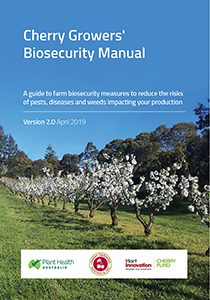Read the latest information on
Foot-and-mouth disease
 A new version of the Cherry Growers’ Biosecurity Manual is now available on the Farm Biosecurity website.
A new version of the Cherry Growers’ Biosecurity Manual is now available on the Farm Biosecurity website.
The updated manual stems from a review of the biosecurity plan for the entire industry, something that is done every five years or so to make sure that biosecurity activities are still targeting the highest priority pests.
Rod Turner, General Manager for Preparedness and RD&E at Plant Health Australia, said the plans are about identifying high priority pests for industries, and to tailor plans to manage those pests should they make it to Australia.
There’s no room for complacency. Pests are continually on the move around the globe and there have been a few worrying trends developing the last few years adding to the biosecurity risks faced by the industry that could affect growers directly.
“We have identified all of the same high priority pests that were there before, but brown marmorated stink bug, spotted wing drosophila, and Xylella fastidiosa have a much higher risk rating this time around due to their ability to get to Australia,” said Rod.
“These three pests have spread internationally and the ‘approach rates’ to the Australian border [the frequency with which they have been intercepted in cargo pre-border or at the border] has subsequently gone up,” said Rod.
“Growers need to be aware of this, and to be proactive in preventing their introduction and spread on farms.”
To help growers implement biosecurity on-farm, the manual is structured around the Farm Biosecurity six essentials and provides advice specific to cherry growers’ activities.
At the back of the manual, there’s a checklist, where biosecurity measures are categorised into three levels and whether there are any legal requirements to be aware of.
There are also pest fact sheets so growers can familiarise themselves with the pest of greatest concern.

Mick Rouget is part owner of Koala Cherries, located in Yarck in central Victoria
Grower Mick Rouget is part owner of Koala Cherries, located in Yarck in central Victoria. Mick was interviewed for a video to launch the manual and said that on-farm biosecurity was important for his business in terms of trade and market access.
“Specifically, for us it’s pest monitoring and control. We registered our properties for export to specific countries, and that involves mapping [the property] and then installing a certain number of traps to monitor for the presence of Queensland fruit fly and other pests of concern like coddling moth,” said Mick.
While these are pests that are endemic in Australia, overseas markets have no interest in receiving consignments of produce that could be infested with them. Monitoring and trapping provide assurance that that’s not going to happen.
“Once the fruit comes to the packing shed, there’s a protocol for each country, and we understand the specifics of packing for that country.”
The packing process is quite detailed, with electronic sorting, digital cameras, and lot of people inspecting as well.
“On the inspection side of things, a certain number of pieces of fruit per consignment are inspected, initially by sorting by staff and then the QC staff inspect the packed boxes,” said Mick.
Members of industry body Cherry Growers Australia and subscribers to the Cherry magazine should have received a hard copy of the manual, delivered with the Autumn edition.
This project (code CY16010) has been funded by Hort Innovation using the cherry research and development levy and funds from the Australian Government. For more information on the fund and strategic levy investment visit www.horticulture.com.au